Biomagnetic Separation
Application of magnetic nano- and microparticles in biosciences
Separation technology is one of the most complex and important areas of biotechnology. Cost-effective separation techniques are a crucial factor in industrial biotechnology production or molecular biological routine diagnostic procedures.
Biomagnetic separation techniques are becoming increasingly important with a wide range of possible applications in the biosciences. Magnetic micro- or nanospheres can be separated easily and quickly by magnetic forces and will be used together with bioaffine ligands, e.g. antibodies or proteins with a high affinity to the target. The targets can be cells, bacteria or DNA/RNA.
The special advantages of magnetic separation techniques are the fast and simple handling of a sample vial and the opportunity to deal with large sample volumes without the need for time-consuming centrifugation steps.
This also makes biomagnetic separation ideal for automated assay / analysis systems which will play a very important role in the near future.
Magnetic properties
Magnetic particles for bioseparation consist of one or more magnetic cores with a coating matrix of polymers, silica or hydroxylapatite with terminal functionalized groups.
The magnetic core generally consists either of magnetite (Fe3O4) or maghemite (gamma Fe2O3) with superparamagnetic or ferromagnetic properties.
On request, we can produce magnetic cores made with magnetic ferrites, such as cobalt ferrite or manganese ferrite.
Superparamagnetism is when the dipole moment of a single-domain particle fluctuates rapidly in the core due to the thermal excitation so that there is no magnetic moment for macroscopic time scales. Thus, these particles are non-magnetic when an external magnetic field is applied but do develop a mean magnetic moment in an external magnetic field.
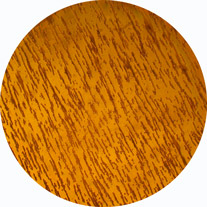
Superparamagnetic particles under the influence of an external magnetic field
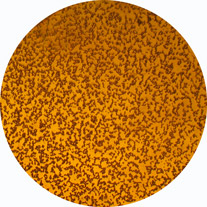
Superparamagnetic particles in absence of an external magnetic field, monodisperse particle distribution
In contrast, ferromagnetism means that the particles have a permanent mean magnetic moment. Here, the larger effective magnetic anisotropy suppresses the thermally activated motion of the core-moments.
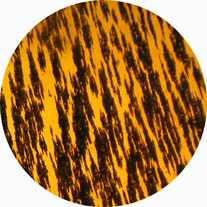
Ferromagnetic particles under the influence of an external magnetic field
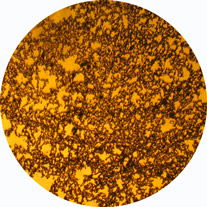
Ferromagnetic particles in absence of an external magnetic field, lattice form
Advantages of the superparamagnetic particles are easy resuspension, large surface area, slow sedimentation and uniform distribution of the particles in the suspension media.
Once magnetized, the particles behave like small permanent magnets, so that they form aggregates or lattice due to magnetic interaction.
Advantages of ferromagnetic particles are very strong magnetic properties and therefore the fast separation with an external magnetic field even in viscous media.
We recommend ferromagnetic particles for the separation of DNA/RNA (SiMAG/MP-DNA), whereas superparamagnetic particles are more suitable for all other applications.
Definition of particle size
The particle size (particle diameter) is given as hydrodynamic diameter, which includes the core diameter and two times the diameter of the cover matrix.
The hydrodynamic diameter is determined by Dynamic Light Scattering (DLS) also known as Photon Correlation Spectroscopy (PCS).
As fluidMAG particles offer a very hydrophilic with water molecules filled polymer matrix a smooth transition appears between the matrix and the surrounding liquid of the suspension. Hence no exact defined surface edge is given. However SiMAG particles possess a solid cover matrix. Therefore a distinct transition between the solid matrix and liquid suspension medium exist and the hydrodynamic diameter is accurately determinable.
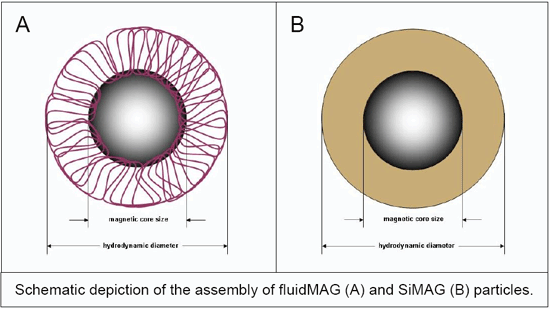
Definition of weight of volume
The weight of volume is defined by the amount of magnetic particles in gram per volume unit and is gravimetrically determined from a well measured volume of the suspension medium.
The weight of volume is not identical with the particle concentration as the numbers of particles per volume unit in a suspension will change due to the force of gravity.
- U.O.Häfeli, W. Schütt, J. Teller, et al. (Eds), Scientific and Clinical Applications of magnetic Cariers, New York, 1997.
- Journal of Magnetism and Magnetic Materials 194, 1999, Proceedings of the Second International Conference on Scientific and Clinical Applications of Magnetic Carriers.
- Journal of Magnetism and Magnetic Materials 225, 2001, Proceedings on the Third International Conference on Scientific and Clinical Applications of Magnetic Carriers.
- Journal of Magnetism and Magnetic Materials 293, 2005, Proceedings on the Fifth International Conference on Scientific and Clinical Applications of Magnetic Carriers.
- Journal of Magnetism and Magnetic Materials 311, 2007, Proceedings on the Sixth International Conference on Scientific and Clinical Applications of Magnetic Carriers.
- Journal of Magnetism and Magnetic Materials 321, 2009, Proceedings on the Seventh International Conference on Scientific and Clinical Applications of Magnetic Carriers
| Scientific and Clinical Applications of Magnetic Carriers | http://www.magneticmicrosphere.com | |
| BioMagnetic Research and Technology | http://www.biomagres.com |
| Technical services: |
|
|
| Bulk quantities: |
|
|
| Free samples: |
|
|
